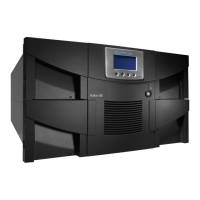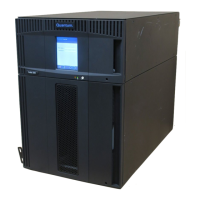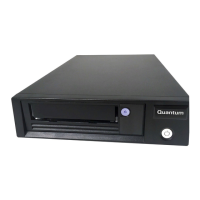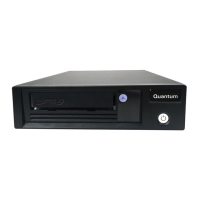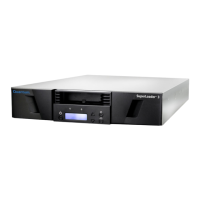162 Configuration Tab
SCSI Target Tab
The SCSI Target tab is designed for the configuration of the Target part of the SCSI interface.
The SCSI Target is an intermediary between the logical library (configured by the Scalar DLC) and the
SCSI. This intermediary requires a configuration that is executed into two steps. First, the SCSI target must
be configured. Second, the Scalar DLC SCSI Client(s) must be created and assigned to the appropriate
logical libraries. The fist step is executed here. The second step is executed via the Clients tab. Refer to
SCSI Client
on page 147.
The SCSI client (either a person or a software application) connects to the Scalar DLC via the LUN object
that is shown to it as a part of the Target on a SCSI bus. One LUN may contain one client (SCSI Client).
The Target always contains LUN 0 and may contain other LUNs; the number is limited by the SCSI HBA
properties. All initiators of the SCSI bus may use the LUN configured for that bus. The physical connection
is established via the host bus adapter (this hardware is called SCSI Adapter, the model of adapter does
not matter if it is supported by the Scalar DLC software). Table 1
on page 6 describes the target adapters
the Scalar DLC software currently supports.
The host bus adapter sends and receives commands via the channels called SCSI Ports. Depending on the
command stream direction, the ports are operating either in Initiator or Target mode (called Initiator ports or
Target ports). The Scalar DLC works with the Target ports only, the initiator mode is not used for the port
configured as Target. The configuration of the Target mode for the SCSI Ports is executed via the SCSI
Target Port Tool (refer to S
CSI Target Port Tool on page 217).
The Targets and LUNs are created manually. After the LUN is created, a SCSI client can be added as an
intermediary between the logical library and the LUN object that represents an initiator of the SCSI bus (it
can be either a user or a software application).
Table below shows the icons that represents the SCSI Target tab objects.
Note
This tab is accessible only if the Scalar DLC SCSI Client component is installed.
Table 22 SCSI Target Icons
Name Icon Text Color Description
Available
port
Black Indicates a SCSI Port (available).
The port is functional, and the connection with the initiators
can be established.
Not available
port
Gray Indicates a SCSI Port (not available).
The port will be functional after enabling, but the connection
with the initiators currently cannot be established. The new
targets cannot be added but all operations with the existing
targets are enabled.
Absent port Light-gray Indicates a SCSI Port (not present).
The port is not functional. The new targets cannot be added
but all operations with the existing targets are enabled.
Active target Black Indicates a SCSI Target (active).
There is a client configured for this target at LUN 0. The SCSI
bus initiators may now work with the target.
Not active
target
Gray Indicates a SCSI Target (not active).
The target LUN 0 is ready to accept a SCSI client. The SCSI
bus initiators may not work with the target until it will be active.
